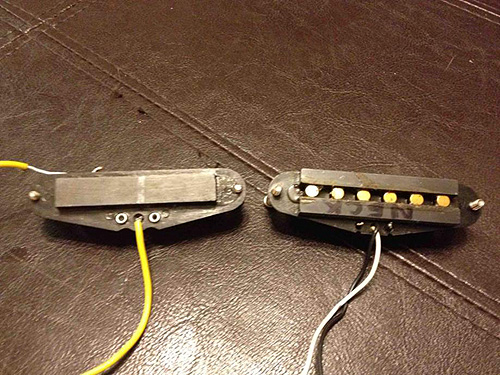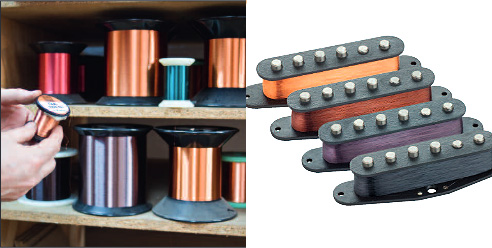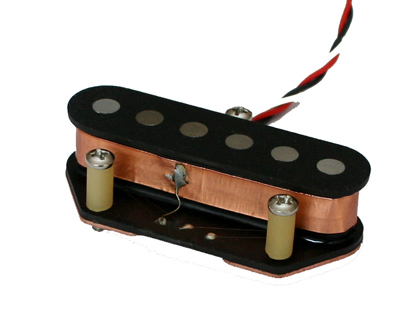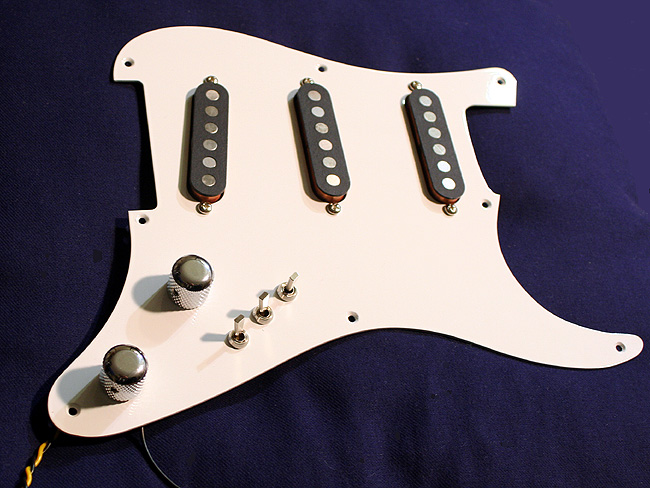It seems to be out of question that the pickups are an important ingredient that defines the sound of an electric guitar. Besides obvious contruction differences – like overwound single coil pickups, or single-coil sized humbuckers etc. – there are many details , like different magnet alloys or different wire for the coil, that make a subtle or even clear sound difference. And there are many ‘external’ aspects, like shielding, pickguard materials etc. that might also influenece the sound of a pickup. And of course there are many myths and speculations about what else is said to be important as well – some can be true, others probably not.
With this blog post I want to list and describe some of such aspects, and let you know my opinion on what is important, and what is not. I have a long experience with pickups, so I have tried out much myself, and I think I can judge other questions from my technical background knowledge. Of course there are other things where I am not sure myself, as I have not a/b compared each single possible combination of pickup features within the same guitar, but I will let you know my guess here as well. Much of the stuff I will discuss will be with the typical Strat pickup in mind – the probably most important pickup for us Knopfler fans, but many results will of course also apply to other pickups. So let’s start with the…
Pole pieces material
First, there are pickups with Alnico (an AL-uminium/ NI-ckle/ CO-balt alloy) pole pieces and pickups with steel pole pieces which touch a ceramic bar magnet on the underside of the pickup (‘ceramic’ pickups). The Alnico pickups often have a stronger magnetic pull to the strings which makes them sound more snappy, also they are considered to sound warmer, while the ceramic pickups are said to sound more sterile, or even harsher. Ceramic Strat pickups can be found e.g. in some Squier Strats, and often in low-end guitars, but e.g. the last Van Nuys era Schecter pickups, the ‘Monstertone’ pickups developped by Tom Anderson, are ceramic as well (these are NOT the Schecter F500T pickups that Mark Knopfler had in his Schecters).

Both will definitely sound more or less different but I have heard many ceramic pickups that actually sounded great, so I would not agree that these are generally inferior. It is rather a matter of what you want or prefer, or maybe also which pickup sounds best in a particular guitar.
Among the Alnico pickups, there are many different alloys, with Alnico V or II being the most important ones. In these the proportions of the three main ingredients aluminium, nickle, and cobalt are different. Alnico V is surely the most important one for Strats, all the original Fender pickups used it. However, there are some who believe that e.g. the Alnico available in the 50ies or 60ies was possibly closer to what comes as Alnico II these days, or that over time the magnets changed – e.g. lost a part of their magnetic strength – and sound for this reason more like a different alloy than Alnico V. Generally V is stronger than II, and the sound is snappier with more punch and direct treble than the softer and warmer sounding Alnico II. Other alloys like Alnico III are also used, possibly in vintage Gibsons or Fenders as well. The problem is that nobody knows for sure what these companies ordered then, or if they sometimes simply changed to a different alloy as e.g. cobalt prices went up, or simply something was not in stock when they ordered.
Conclusion: Makes a sound difference, normally clearly audible
Winding wire insulation
The hair-thin wire for the coil is always made of copper. To wind a coil, you cannot use bare copper wire, it has to be insulated. As it is extremely thin wire, this insulation is not the coloured plastic like on ‘normal’ cables, but often a clear coat that is not visible with the bare eye. This insulation can be made of different materials, e.g. Formvar or enamel on old Fenders, but also polyurethane or polyamide is used.

As this is just an insulation, you might argue that a different material should not lead to any sound difference. However, it does! How is this possible? This is because all the wire of the pickup coil makes a capacitor – remember from your school days, two opposite metal plates that do not touch make a capacitor. Instead of metal plates we have the wire here, and all the surface of each single winding lies next to another winding, so they make a capacitor as well. Maybe you also remember that the insulating material between these metal plates – e.g. air, oil, paper,.. – also changes the value of the capacitor. So the same is true for the wire insulation, all the different materials have their own specific ‘dialectric constant’ that influences the overall value of the capacitance.
Not only the material matters, but also the thickness of the insulation. Remember the capacitor at school, the distance between the metal plates matters. While the insulation is always ‘thin’, it still has a thickness that is not to be neglected. And sometimes the insulation is even thicker for a more durable wire, so called double-coating. When talking about old Fender pickups,you will hear terms like heavy Formvar, or plain enamel. Heavy means double coated here, and plain means single coated.
Conclusion: Wire insulation makes an audible difference as well. It depends not only on the material (Formvar, enamel,..) but also on the thickness so it is difficult to say what exactly sounds like what. The difference might be subtle – but I could assure myself that I can hear it.
Potting
Pickups are normally potted with hot wax, sometimes also with laquer (e.g. old Tele nek pickups). This is done to avoid that the pickup is too microphonic. The loser the coil is wound, the more microphonic the pickup might be. You will not only hear a louder noise when e.g. tapping on the pickup (with a non-magnetic material, e.g. with your fingertips), but this will also increase the danger of squealing feedback at high volume.
The wax (or laquer) can change the ‘dialectric constant’ of the coil as a capacitor (see the passage above), so it can make a sound difference. Some of the early Gibson PAF pickups are said to be non-potted, or hardly potted. The sound might becoame a bit ‘airier’ without the wax.
Conclusion: Theoretically possible, but a rather subtle difference – not too important in most situations.
Connecting wire
Some pickups have cloth-covered push-back cables, others have plastic insulation cables in different colours. I cannot imagine how this should make any sound difference, so it is just a question of ‘vintage-correctness’, or of ease to handle it (push-back cable is nice to solder, you just have to push it back a bit, and it will slide back after soldering).
However, if the cables are drilled – like e.g. the three cables on the Schecter F500T pickups – there might be a small capacity again, however so small that I personally would not bother about it too much. If the cables are shielded however, more capacitance is added which might become audible.
Conclusion: Normally no difference
Age/Magnet strength
A stronger magnet results in clearer and stronger treble, and a snappier tone, similar to the difference between e.g. Alnico V and II (see above). The strength can be measured, and it is a fact that with age magnets can lose a part of their strength. It is possible to remagnetize them to their original strength if they become too weak. The slightly weaker magnets might be one ingredient of vintage tone! Also you should avoid to use a soldering gun (instead of a normal soldering iron) when handling pickups, and for sure be careful when placing your guitar near to very strong magnets (e.g. resting it against a speaker cabinet with powerful speakers). This can not only make the magnet weaker but also cause some weird magnetic behaviour within the pole pieces.
Conclusion: Makes a sound difference.
RW/RP
Single coil pickups will hum when being exposed to certain magnetic fields. The idea of a humbucker pickup was to eliminate this hum by using two coils with opposite polarity. A similar hum cancellation can be achieved with two single coils as well (e.g. when playing the typical Knopfler bridge-middle pickup sound). The two pickups must be wound in opposite directions then (this is meant with RW for reverse winding). To avoid that the sound of the guitar strings is cancelled as well, the polarity of the pole pieces must be different, too (RP for reverse polarity). This idea came up in the 80ies I think. Mark’s Fenders and Schecters at the time of early Dire Straits did not have RWRP for this reason.
Apart from some theoretical reasons related to two coils with different magnetic fields that influence each other, I don’t see how this can affect the sound of the guitar – at least not as much to make an audible difference.
Conclusion: I don’t think it can make an audible difference.
Pickup dimensions
If you look at several old Fender pickups, you will often notice that they all look a bit different. Some seem to be a bit taller so that the pole pieces seem a bit shorter on the top side. This will affect the dimensions of the coil, a flatter coil with the same number of turns will appear wider, while a taller coil will be narrower. The different distance from the wire to the magnets will change the properties of the coil, so this can make a sound difference. A wider one should be a bit warmer, while a taller one should have a bit more treble.
Conclusion: Might make a subtle difference.
Winding pattern
In the old Fender days, the pickups were wound on machines but the wire was guided by hand. When winding more than 8,000 turns on a coil, the girl who operates the machine – mostly girls did this job at Fender – has to make sure that the wire goes evenly on the coil to avoid all wire being in the middle of the coil only, so she will move her hand to guide it from one side of the coil to the other, back again, and so on. If she does it quicker, or even at some random pattern, you will get what is called a scatterwound coil. The pattern in which one layer of wire lies to the next, or even one turn of wire, might again influence the capacity, and possibly other properties of the coil as well.
Conclusion: Might make a subtle difference.
Screws, rubber tube, springs
This should not make any sound difference. It is true that each piece of metal that comes into the field of a pickup affects the tone, due to an effect called eddy currents (see below), but different pickup screws, or a metal spring instead of a piece of rubber tube to hold the pickup, should not be enough metal to make it audible.
Conclusion: Not important for the sound.
Base plate / Metal cover
The original Telecaster bridge pickups had a piece of metal below their bottom bobbin. This changed the field of the coil, and also reduced treble due to eddy currents. Some maunfacturers add such a plate to some Strat pickup models as well, often for the bridge pickup, to boost bass a bit and make treble end softer.
The same is true for a metal case, as. e.g. on a Tele neck pickup, or on a PAF humbucker. Removing / adding these will make a clear sound difference (more treble without case).
Conclusion: Make a clear difference.
Distance between pickups and the strings
The closer the pickup is to the strings, the louder the pickup will be. The sound also becomes more direct, more snappy and punchier. However, you will get the infamous ‘Stratitis’ effect, a strange wobbling and somewhat ‘out of tune’ sound as the magnetic pull makes the string vibrate unevenly.
Conclusion: Besides the volume differnce and the Stratitis, this will also affect the tone to some extend.
Shielding
To avoid hum from electric fields (it does not help much against magnetic fields), some manufacturers use a shielding foil, or an aluminium shielding plate below the pickguard. Believe it or not, this can make a sound difference, due to possibly added capacitace but more because of what is called eddy currents. These will dampen the resonance peak of the pickup, and also change the frequency response close to this frequency. The more metal you have within the magnetic field, the stronger the effect. This means a very thin foil will not make an audible difference, but the 0.3 mm shielding plates of those 60ies Strats – like Mark used to play – does.
Schecter F500T pickups have a loop of shielding copper tape around the coil. This also makes a difference – even a big one! This is mainly because of added capacitance, plus some eddy currents.

Conclusion: Not with a very thin foil, but can make a difference otherwise.
Pickguard material
It should not matter if the pickguard is 2 or 3 millimeters, or of vinyl or celluloid BUT … if it is made of metal it will have a big effect on the tone! This is because of eddy currents again. The aluminium pickguard on Mark’s red Schecter Strat clearly changes the tone of the pickups a lot! The effect is much stronger than most other aspects discussed before. You might say there is only a subtle sound difference between e.g. an original Fender vintage pickup and a good replica like the Seymour Duncans which Mark put in his red Schecter, but there is a huge difference between the same pickups in a plastic or metal pickguard. This is a part of the Schecter Dream Machine sound but there were many old Fenders with anodized aluminium pickguards as well (e.g. David Gilmour’s #0001 Strat). Search on youtube, you will find many videos to demonstrate this.

Conclusion: Makes a big difference.
Volume and Tone pot values
Makes clearly difference, see this blog post for more info.
Guitar cable quality
The quality of the guitar cable also makes a sound difference. Each cable has a capacitance, a typical cable about 30 pF per feet. So the longer the cable, the more capacitance, but the distance between the inner lead in the cable and the outer shielding also affects the total capacitance. The resonance frequency of a Strat pickup will shift from about 8 kHz without a cable to something like 2 – 5 kHz with a cable! An 8kHz resonace peak will not sound ideal for many situations, definitely not for most distorted sounds, so the cable really shapes the sound here, adding (!) midrange to the sound while reducing treble.
Conclusion: Can make a big difference.
Others
The material, or colour, (black/grey fiber board, plastic) of the pickup bobbins should not matter at all.
Bevelled/unbevelled pole pieces however can make a very subtle difference as the magnetic field can be a bit stronger, or more focussed, at the end of a bevelled magnet (bevelling was done to make it easier to push the pole pieces into the bobbin, not to shape the sound).
The material or thickness of the plastic caps does not matter. An original or rewound coil should not matter if everything is exactly the same (which in fact hardly ever will be) but generally a good rewinding job with the right materials does not automatically mean a loss of sound.
Staggered or flat pole pieces lead to different volume of the individual sound, and other effects due to a different magnetic field are possible but seem to be unlikely to me.
The tension of the wire while winding makes a subtle difference. With more tension the wire is puuled and becomes thinner a bit, so the DC resistance per turn will increase.
Of course different wire gauge (AWG 43, AWG,43,…) makes a big difference, so does different pole pieces diameter, but these are really differences that totally change the design of the pickup and should not be considered here in this list for this reason.
A Tele bridge pickup will sound different in a Tele bridge of massive brass – like the Walk of Life tele bridge – than in a Fender vintage bridge of much thinner steel. This is due to eddy currents again, and adds to the tone change of a brass bridge vs. a steel bridge (that can also be heard acoustically with the unplugged guitar).

4 thoughts on “The sound of your pickups – What makes a difference, what not?”
Hi Ingo,
Thanks for all the hard work. It’s always interesting to read what you’ve been up to.
On my train journey home last night I pondered why pickups behave like a microphone and produce signals in sympathy with more than just the strings vibrating – if you tap the pickguard of a plugged-in guitar with a pick, you hear it at the amp. I figured that the reason for this is that the vibration causes the coils of the pickup to vibrate very slightly and this produces a signal roughly equal to the frequency of the sound of the vibration.
With that in mind, on a strat the only thing holding the pickups in place is the pickguard. So the material, mounting and density of the pickguard would, according to this theory, affect how the pickguard vibrates in sympathy with the strings and the rest of the guitar. So, yes, the material should matter a great deal.. and so would the manner by which the pickups fastened to the pickguard.
I don’t know whether this a greater or lesser effect than the eddy currents you talked about in the article, but worth considering I think.
Cheers,
Tom.
Hi, Im a brazilian guitar manufacter, and wanted to know how much change in tone can a iron pickguard do in a single coil.
Thanks
It is subtle but you can hear it easily. It dampens the resonance peak of the PU about 2-3 dB, possibly also lowers it. Unfortunately it will also increase the danger of feedback – the metal pickgurd might vibrate and induce whistling noise, like a Tele bridge.
I have only experience with aluminium and brass pickguards here but I guess steel will sound the same although it is magnetical and the other metals are not.